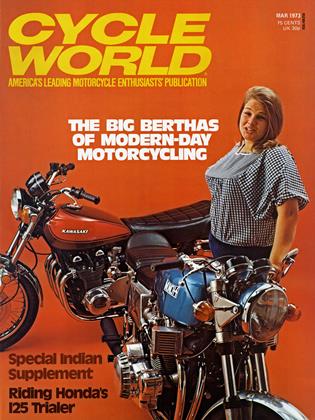THE SERVICE DEPT
JODY NICHOLAS
MORE RELIABLE?
I will be receiving my 1972 Norton Commando Interstate next month and I was hoping you could offer a few ideas or suggestions that would help to improve the reliability and the durability of the Norton.
I feel the bike has more than enough power for my intended usage and I want to reduce the compression slightly by adding a second base gasket. By doing this I would hope to increase engine life. Do you feel this would have any adverse effects besides slightly reducing power?
I also intend to add an oil filter/cooler combination to the new Combat engine.
I was once told that tearing a new engine down and checking for burrs, rough spots, etc., would improve engine performance and life and by doing the same to the transmission, would get smoother shifts and there would be fewer metal particles floating around. I imagine the reason for this is that shop practice and quality checks aren’t too good. Is this true or is it just a memory of the good old days?
Loren C. Barnes New York, N. Y.
You state that you wish to reduce the compression ratio of your new Norton with the Combat engine by adding a second base gasket. I’m afraid that making such a change would hardly be worth the trouble because a base gasket is made of paper and is only about 0.003-in. thick. The reduction in compression ratio would hardly be measurable.
The best thing to do would be to order your Interstate with the standard Norton engine which has a compression ratio of 8.9:1 instead of the 10:1 ratio of the Combat engine. Aside from the lower compression ratio the standard engine has a slightly milder camshaft and has smaller carburetors. This would be a more reliable engine than the Combat, but won’t be quite as fast.
With modern manufacturing methods being what they are, it is likely that stripping the engine and transmission to remove any burrs or rough spots would be a waste of time unless you are planning to race the machine right > away. Actually, those results are achieved by careful break-in procedures during the machine’s early life.
BETTER BLUE THAN RUSTY
I own a 1969 BSA Firebird Scrambles and I am having problems keeping the pipes from “blueing. ” Can you tell me what causes this and how I can correct it? If it’s “just one of those things,” can you recommend a good way to clean them? Also, where can I get a shop manual for the above bike? Nobody seems to have one.
Douglas Hyde Stow, Mass.
Practically all motorcycles will blue the exhaust pipes after a time. This coloring, which ranges from a light straw color to a deep violet or even almost black, is caused by the heat from burned fuel/air mixture exiting the engine through the exhaust pipe.
Older model BSA Twins (A-7 and A-10 series) with a manually controlled spark advance weren’t nearly so prone to blueing as the newer models with an automatic spark advance mechanism.
You might notice that many of the newer Honda models don’t seem to blue their exhaust pipes nearly as badly, if at all. This is because the outer exhaust pipe doesn’t have any burned gases going directly through it. There is a smaller diameter inner pipe and an air space between the two “layers” of exhaust pipes.
There are a few proprietary compounds available which will aid in the removal of heat-caused blue from the exhaust pipes, but there is another far more serious disadvantage: the compounds also remove the chrome plating!
Write to the Birmingham Small Arms Co., P.O. Box 6790, Towson, Baltimore, Md., for information regarding a shop manual for your Firebird. B]















